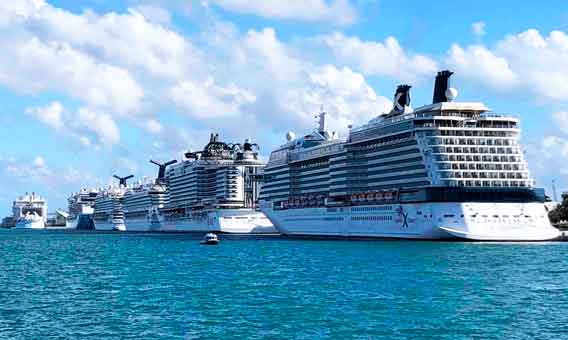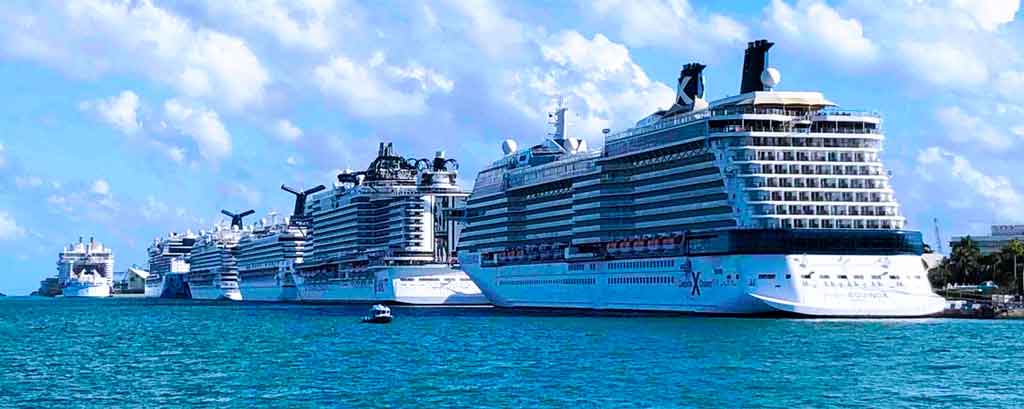How and Why Passengers and Crew
Got Stranded on Cruise Ships for months
Although all cruise lines have suspended operations in the middle of March 2020, a very large number of cruise ships were are not able to disembark crew and passengers because cruise ports refuse entry.
After the announcements, on March 13, by cruise lines and the White House that all ship operations would suspend within a couple of days, due to the outbreak of Coronavirus Covid-19, you would probably think that docking cruise ships, disembarking passengers, crew, staff, and officers was an easily done deal.
But the reality is that like many decisions relating to the Coronavirus outbreak, there is a big difference between words and acts. And, once again, straightforward decisions that look like obvious and simple turn out to be very complicated to implement and may have unintended and dramatic results.
Consequently, at least 30 cruise ships, with thousands of passengers, crew, officers, and staff were roaming the world looking for a port to disembark with the logistics getting more and more complicated as days went by.
Most passengers disembarked cruise ships on March 14 and 15
A very large percentage of cruise passengers (and some crew members) were able to disembark ships in the first days after March 13, whilst major ports in the United States, Australia, and Asia were open.
As a matter of fact, just on Saturday and Sunday (March 14 and 15) over 80,000 cruise passengers disembarked 15 ships in the Port of Miami (as the Editor did). Almost as many cruise passengers disembarked in Port Everglades on the same days. And tens of thousands more disembarked cruise ships all over the World.
Cruise ships docked in Port Everglades
Photo © IQCruising.com
HOWEVER, following President Trump’s announcement requesting four major cruise lines (Carnival, Royal Caribbean, Norwegian, and MSC) to suspend operations due to the Coronavirus outbreak, cruise ports all over the World started to refuse disembarkation of passengers.
As ports turned cruise passengers away, cruise lines have been scrambling to find ports to disembark passengers.
For those that are not familiar with the cruise industry’s dimension and logistics, it may be difficult to understand why there are still cruise ships roaming the World’s oceans so many days after the suspension of cruise operations.
Why are cruise ships stranded?
The reality is not that complicated to grasp. To start with, it should be understood that the Coronavirus outbreak started in the peak of the Fall-Winter cruising season. And that this is the best time for cruise passengers to explore three main regions of the World: the Caribbean, Pacific-Asia and South America.
In fact, you don’t have to be a rocket scientist to realize that cruising Alaska or the Norwegian fjords in the winter is both dangerous and doesn’t offer much of scenic (cruise) experience.
You don’t have to be a brain surgeon to understand that the best time of the year to cruise South-America is during the southern hemisphere's Summer; or that the peak of the season to cruise the Caribbean is when the weather is at its best (avoiding the Hurricane Season - between 1 June and 30 November).
Why was it easy to disembark the majority of cruise passengers before March 15?
As a large percentage of ships were cruising the Caribbean during its peak season, it was relatively simple for cruise lines to disembark passengers in a short period of time and with short notice for two basic reasons.
First, because all cruises exploring the Caribbean depart (and return) to American ports like Miami, Fort Lauderdale, Port Canaveral, New York, New Jersey, Galveston and so on. Secondly, because most cruises to the Caribbean have a relatively short duration – between 3 and 10 days. Thirdly, because the majority of cruises depart/return on Saturdays and Sundays.
Therefore, when it was decided on a Friday (March 13) to suspend operations due to the Coronavirus outbreak, it was relatively simple for cruise lines to disembark all passengers finishing a cruise in American ports (on Saturday and Sunday, March 14 and 15, respectively) and not embark new passengers.
In the case of cruises that had started on a previous weekday, all cruise lines had to do was to interrupt the cruise, turn the ship around and disembark passengers as soon as possible. In fact, there were many cruise passengers disembarking ships as late as Thursday, March 19.
But what about the cruise ships that were cruising in other regions like South America or Asia-Pacific. How and where would cruise lines be able to disembark passengers?
How cruise ships got stranded?
Most cruise lines were proactive and anticipated the major challenges that were foreseeably hitting the hospitality industry with the Coronavirus outbreak. In fact, as early as January 27, cruise lines started to suspend operations in China as the Coronavirus outbreak forced the closure of ports like Shanghai and later on Singapore.
Most cruise executives realized straight away that the best things to do would be to get ships out of the Southeast Asia region and move to safer shores, as Regent Seven Seas, Royal Caribbean and others did.
But not all cruise lines were able to do so straight away, did not have any reason to foresee what was coming and, in some cases, geographical realities are not easy to overcome. Crossing the Pacific Ocean can take up to 15 days and ships need to refuel and get supplies.
Besides, back in February, most people (and politicians in particular) were still believing that the Coronavirus outbreak was a regional epidemic confined to China, which was beeing used by media sensationalism for political reasons. Consequently, many cruise lines moved away from Chinese ports but stayed in the Pacific region.
For example, on February 17, the Editor received an updated itinerary for the World Cruise on the Amsterdam, a Holland America cruise ship, as he was supposed to embark in Bali (Indonesia) on March 20 and disembark in Cape Town on April 21.
But by March 3, the itinerary was changed and two days later it changed again. And, it kept changing, and changing and is still changing as cruise lines struggle to find ports to disembark passengers and book flights to return them home.
The same is happening with cruise ships that were cruising the South Pacific or South America, as late as mid-March. On Tuesday, March 24, there were around 30 cruise ships, with as many as 50,000 passengers and around 20,000 crew members, still trying to get to a port that will allow cruise passengers and crew to disembark and fly back to their home countries.
Why cruise ports turn ships away?
Because of the sudden realization that the Coronavirus outbreak was not confined to China, cruise ports all over the World started to block ships from disembarking passengers out of anxiety and fear.
The panic was essentially provoked by a couple of situations that occurred back in January – the decision of Japanese authorities to quarantine passengers and crew (3,700 in total) for 18 days onboard the Diamond Princess; and a similar but shorter quarantine imposed on the Grand Princess by USA authorities, back in February.
With over 330 cruise ships in the World, these two sensational stories tainted the cruise industry in the age of Coronavirus and fed the most uninformed opinions, irrational behavior and inhumane decisions.
Populace Protest
On March 2, the Sun Princess cruise ship arrived in the Pointe des Gallets Port (Réunion Island), a French territory off the East coast of Africa. Although there were no cases of Covid-19 on board, local protesters gathered at the exit gates of the port throwing rocks and screaming abuse at tour buses with cruise passengers planning to explore the attractions of the island.
Naturally, the ship’s Captain ordered the buses to return to the ship and headed to the next port on the Republic of Mauritius. But, overnight, this port refused entry as did the following port in Madagascar.
After been turned away by three cruise ports, the Sun Princess ended up on an eight-day journey across the Indian Ocean back to Fremantle (Australia), where she arrived on March 10. But 30 other cruise ships were not able yet to find a safe port to disembark passengers and crew.
Coronavirus Panic and Politics
The fear, anxiety, and panic of this irrational behavior has spread Worldwide. Some supposedly intelligent conservative people are even advocating that cruise lines should just sink – Alexander Holt, on National Review, March 20. Or that, according to democrat ex-presidential candidate Tulsi Gabbard, “cruise ships are basically floating incubators for Coronavirus”.
We do not think so. To be blunt: we think these sensational opinions are based on very poor understanding of the cruise industry and even worst judgment. As much as the reactions of the populace of Réunion Island, Mauritius and Madagascar can be understood, those of supposedly intelligent political actors are not.








